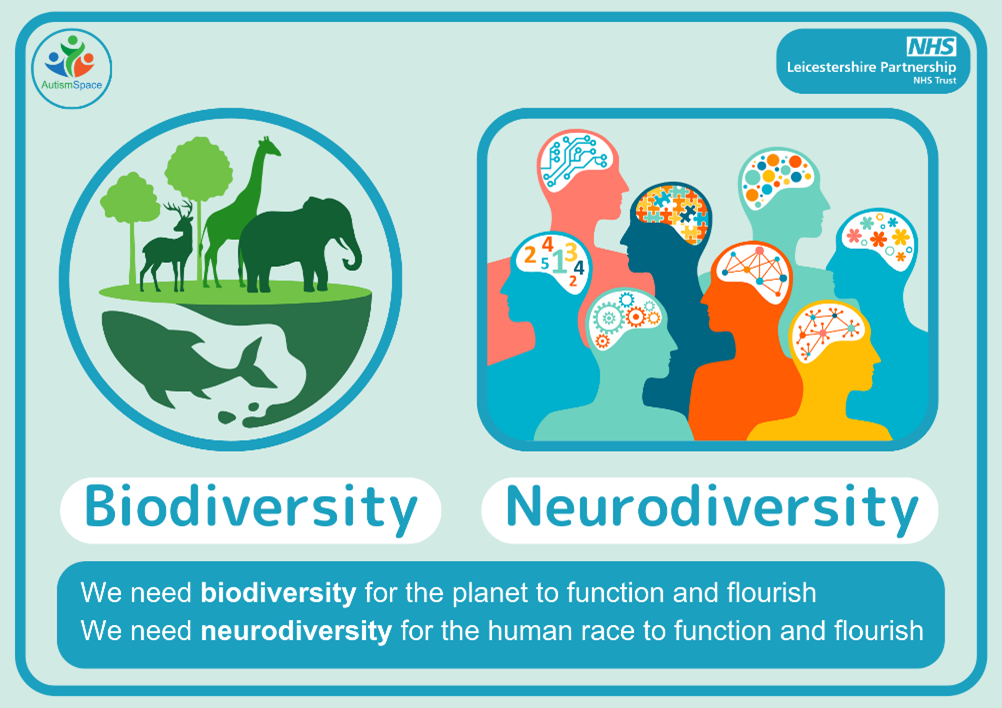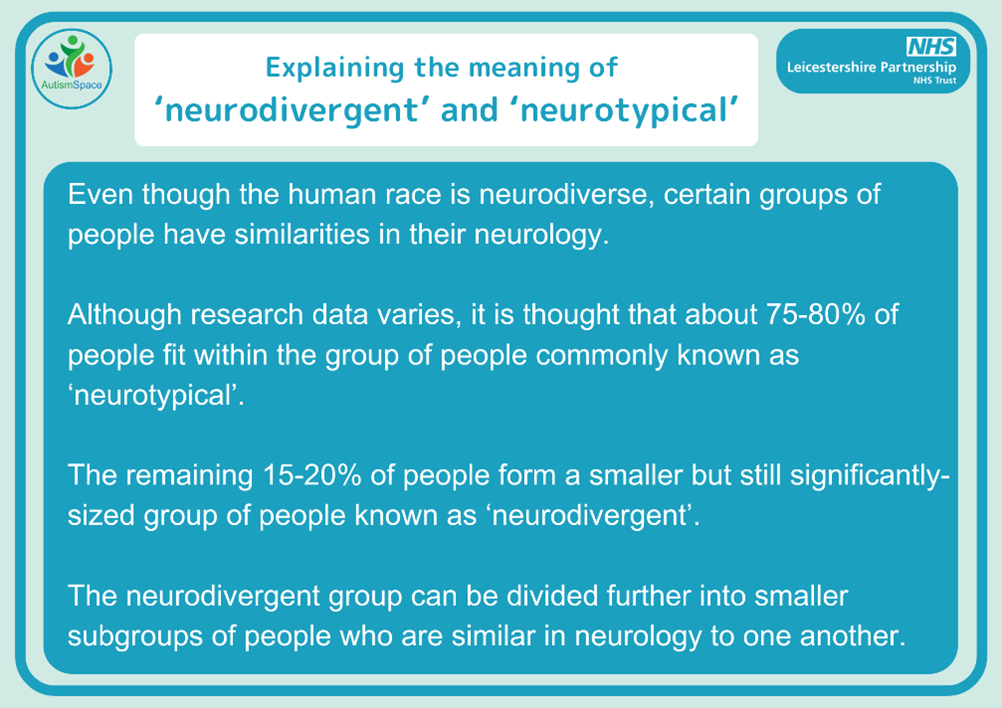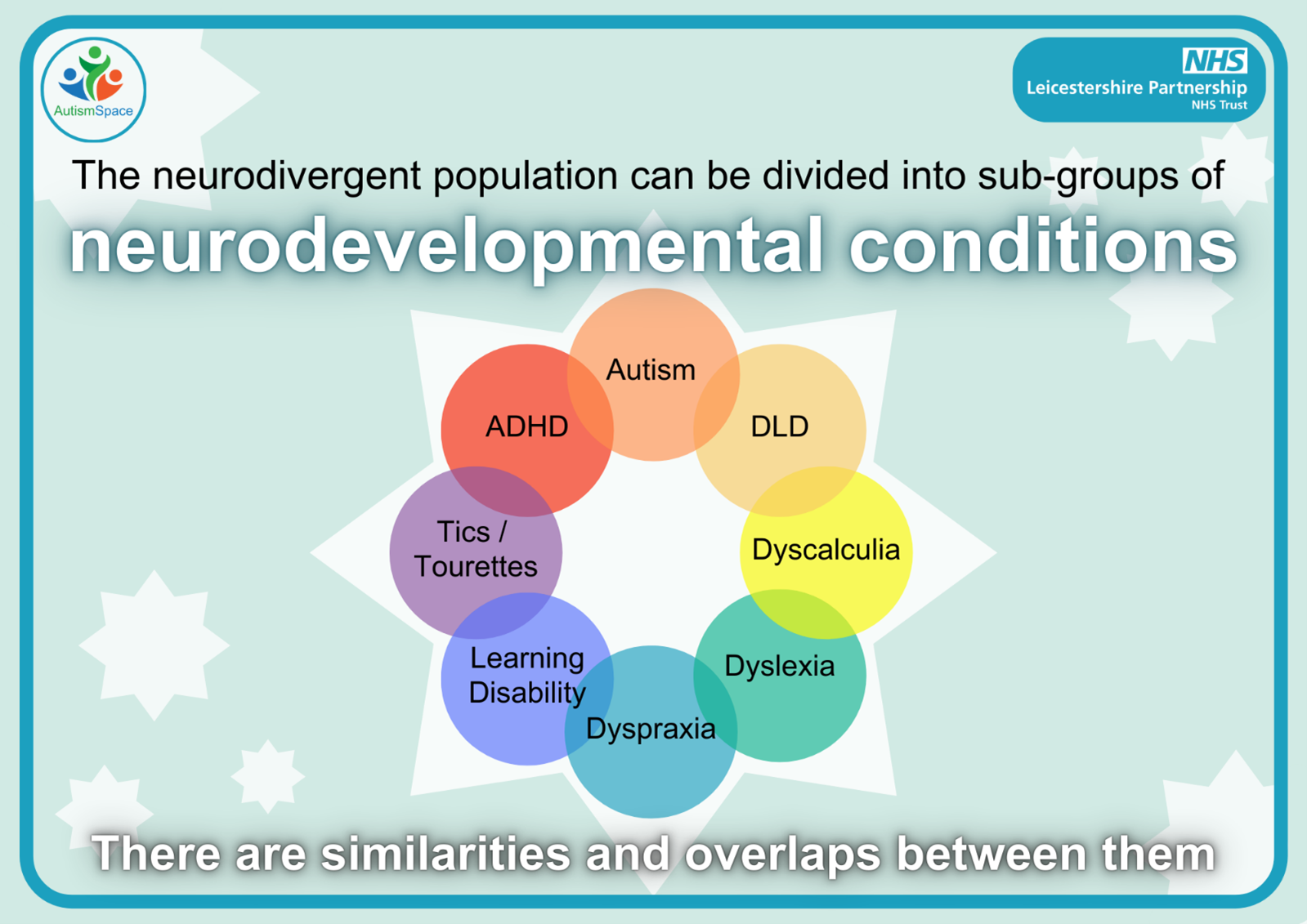This explanation is quite complex. To understand the key words, it might help to read the poster (link below) produced by CAPTAP (Community Against Prejudice Towards Autistic People).
Click here to view the language guide by CAPTAP
The term neurodiversity was coined in the 1990’s by the autistic online community. It has since been included in the written works of many academics and researchers and is now a popular and respected model of explaining differences in human neurology – or what we might call ‘brain-wiring’.
The neurodiversity model highlights that when it comes to neurology, every person is unique. It recognises that each person’s individual neurology produces unique thinking styles and behaviours.
It also emphasises that these variations in human neurology are normal.
The subgroups of neurodivergent people include those who have the following types of neurology.
- ADHD (Attention Deficit Hyperactivity Disorder)
- Autism
- Developmental Language Disorder
- Dyscalculia
- Dyslexia
- Dyspraxia – also known as Developmental Co-Ordination Disorder (DCD)
- Learning Disability
- Tics or Tourette’s
These types of neurology are known as ‘neurodevelopmental’ which essentially means they are established during early development and are lifelong. They are often known as ‘neurodevelopmental conditions’.
Similarities and overlaps between various neurodevelopmental conditions
A 2024 Birmingham University study on neurodiversity (source and link at bottom of article) in the UK population showed that:
- There are characteristics and experiences that are common to individual neurodevelopmental conditions.
- It is also possible for two people with the same diagnosis to have rather different features.
- There are also factors that might be common across neurodevelopmental conditions. This means there is considerable overlap of common factors between various conditions.
- People with high levels of characteristics and experiences common to one condition, often also have high levels of characteristics and experiences common to other conditions.
- It is common for people to have more than one neurodevelopmental condition.
Autism and ADHD
It is estimated that about 40% of autistic people also have ADHD. This combination is often referred to as AuDHD.
Autism and Learning Disability
Autism is not a learning disability – however, as we know, overlaps between neurodevelopmental conditions are common.
It is estimated that about 1 in 3 autistic people also have a learning disability.
About 3 in 10 people with a learning disability also have an autism diagnosis
Click this link to find more details on autism and learning disability from Autistica.
Why autistic people face more challenges than most people
As we know, most people on the planet are neurotypical. Therefore it is fair to say that most systems and environments within society – such as schools and workplaces – are largely designed, set up and maintained by a majority of neurotypical people. And we could say that most of the time, it is the needs of the largely neurotypical population that are catered for, whereas the needs of autistic people are often not fully considered.
When we take this into account and also remember that autistic people’s neurology, thinking and behaviours are different by comparison to those of neurotypical people, it helps us understand why autistic people often face difficulties and challenges.
Common autistic strengths
The neurodiversity model helps to explain why autistic people might also have certain characteristics that can be seen as strengths. It is important to remember that no two autistic people are the same – however, there is evidence to support the fact that autistic people often tend to excel in certain areas.
- being experts in their favourite topics/activities
- the ability to ‘hyperfocus’ i.e. spend a long time engrossed in a particular task
- having a strong sense of justice
- creativity
- ability to notice detail
- honesty
- loyalty
- creative problem solving
- less influenced by socially-derived biases
- excellent memory
In summary
When it comes to ‘brain-wiring’ and thinking styles, every person on the planet is different. We call this difference ‘neurodiversity’.
Despite the differences, there is a large group of the population who are similar to one another. We call these people ‘neurotypical’. The people who are not neurotypical are ‘neurodivergent’.
We can divide the neurodivergent group into smaller sub-groups. These include: autism, ADHD, dyslexia, dyspraxia, tics and Tourette’s and learning disability. These are known as neurodevelopmental conditions. Many people have more than one neurodevelopmental condition.
As the neurotypical population are in the majority, they control most of the environments and systems in society. Due to a lack of understanding about autistic differences, this is why autistic people often face more challenges than most people.
Due to their different brain-wiring, autistic people also tend to have certain strengths that should be embraced.
Sources:
Doyle N. Neurodiversity at work: A biopsychosocial model and the impact on working adults. Br Med Bull; 2020. doi: 10.1093/bmb/ldaa021.





